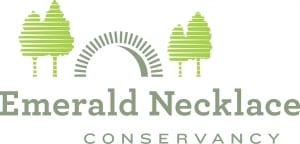MassArt's Backyard: Back Bay Fens

Download a map of MassArt's backyard: the Back Bay Fens.
Or a map of the entire Emerald Necklace.
Books by and About Frederick Law Olmsted
-
Architects of an American Landscape:Henry Hobson Richardson, Frederick Law Olmsted, and the reimagining of America's public and private spaces by
Call Number: NA2543.S6 H685 2022ISBN: 9780802159236Publication Date: 2022 -
Civilizing American Cities:a selection of Frederick Law Olmsted's writings on city landscapes by
Call Number: HT167 .O44 1979ISBN: 0262650126Publication Date: 1979 -
 FLO: a biography of Frederick Law Olmsted
by
Call Number: SB470.O5 R66ISBN: 0801815088Publication Date: 1974
FLO: a biography of Frederick Law Olmsted
by
Call Number: SB470.O5 R66ISBN: 0801815088Publication Date: 1974 -
 Frederick Law Olmsted, Sr.; founder of landscape architecture in America
by
Call Number: SB470.O5 F32Publication Date: 1968
Frederick Law Olmsted, Sr.; founder of landscape architecture in America
by
Call Number: SB470.O5 F32Publication Date: 1968 -
Frederick Law Olmsted: designing the American landscape by
Call Number: SB470.O5 B47 1998ISBN: 0789302284Publication Date: 1998 -
 Frederick Law Olmsted and the American Environmental Tradition
by
Call Number: SB470.O5 F4 1972ISBN: 0807606502Publication Date: 1972
Frederick Law Olmsted and the American Environmental Tradition
by
Call Number: SB470.O5 F4 1972ISBN: 0807606502Publication Date: 1972 -
A Modern Arcadia: Frederick Law Olmsted, Jr. & the plan for Forest Hills Gardens by
Call Number: HT169.57.U62 N75 2001ISBN: 155849314XPublication Date: 2002 -
The Papers of Frederick Law Olmsted by
Call Number: SB470.O5 A2ISBN: 0801817986Publication Date: 1977 -
Archives of Frederick Law Olmstead
The papers of farmer, writer, reformer, landscape architect, urban and suburban planner, and conservationist Frederick Law Olmsted (1822-1903) consist of approximately 24,000 items (roughly 47,300 images), most of which were digitized from 60 reels of previously produced microfilm. The collection, spanning from 1777 to 1952, with the bulk dating 1838-1903, contains materials on both Olmsted's private and professional life.
Find these records at the Library of Congress website.
The Papers of Frederick Law Olmsted
This Rotunda edition of The Papers of Frederick Law Olmsted reproduces in their entirety the contents of ten volumes from the original letterpress edition published by Johns Hopkins University Press: all nine volumes from the Main Series, and Supplementary Series volume 1.
Find the digital contents here.
Olmsted 200
Visit the Olmsted 200 website to learn more about Olmsted and his work:
- He is most famous for his work as a landscape architect, designing 100 public parks to improve the human condition and conserve nature.
- He also served as first Executive Secretary of the U.S. Sanitary Commission, the forerunner of the American Red Cross.
- His writings for the New York Daily News in the 1850s argued for the abolition of slavery.
PBS History
Articles on Olmsted
Dellinger, Matt. "Frederick Law Olmsted’s War on Disease and Disunity." New Yorker, May 16, 2020. https://www.newyorker.com/culture/cultural-comment/frederick-law-olmsteds-war-on-disease-and-disunity. Accessed March 11, 2022.
Green, Jared. "The Injustices of the South Shaped Olmsted’s Vision of Landscape Architecture." The Dirt, June 22, 2021. https://dirt.asla.org/2021/06/22/the-injustices-of-the-south-shaped-olmsteds-vision-of-landscape-architecture/. Accessed March 11, 2022.
"Frederick Law Olmsted and H.H. Richardson: The design dream team of the 19th century." Christian Science Monitor, 15 Feb. 2022, p. NA. Gale In Context: Opposing Viewpoints, https://link.gale.com/apps/doc/A693926320/OVIC?u=mca_main&sid=bookmark-OVIC&xid=33739639. Accessed 11 Mar. 2022.
Rich, Nathaniel. "Better Than Nature: what Frederick Law Olmsted can teach us about how to nurture a planet that has become a park." The Atlantic, vol. 318, no. 2, Sept. 2016, pp. 42+. Gale Academic OneFile, http://ezproxymca.flo.org/login?url=https://search.ebscohost.com/login.aspx?direct=true&db=edsgao&AN=edsgcl.462787396&site=eds-live. Accessed 11 Mar. 2022.
The Emerald Tutu
The Emerald Tutu is a design project to protect Boston Harbor from climate change. MassArt Visiting Lecturer and architect, Gabriel Cira, is one member of the design team behind The Emerald Tutu. He worked with local environmental scientists and policy makers to come up with this project which is a nod to Frederick Law Olmsted's Emerald Necklace. The Emerald Tutu--so called because the meshy marsh mats evoke green tutus-- addresses a modern day environmental issue in a whimsical and inexpensive way. The project has one multiple prizes and a National Science Foundation grant.




